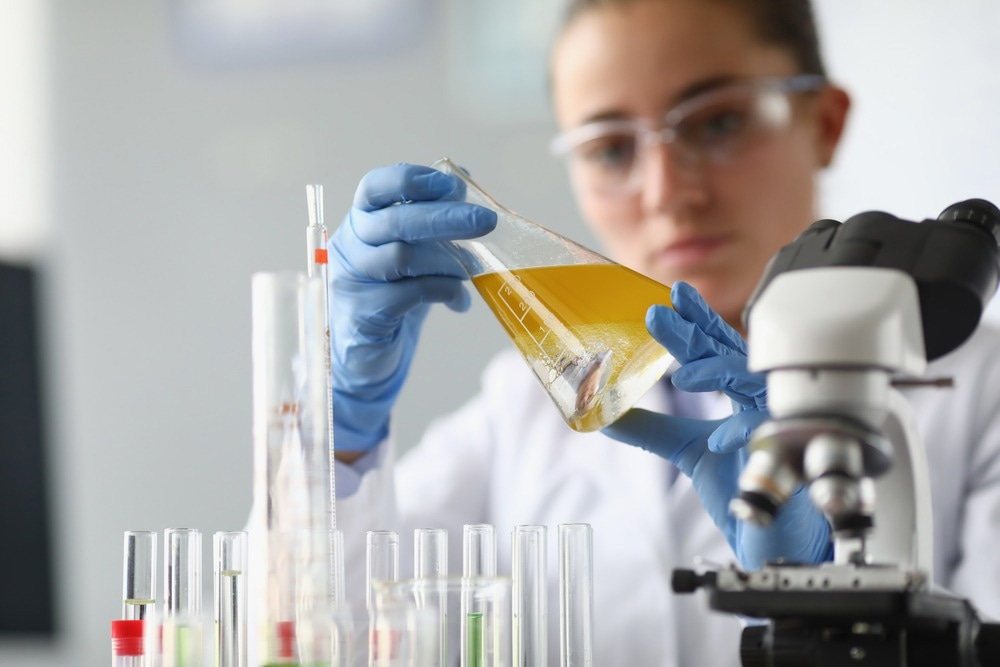Petroleum Chemistry deals with the study of petroleum products ranging from crude oil to gasoline, liquid petroleum gas, and diesel. These products are valuable raw materials in the chemical industry, making the study of their physicochemical properties and compositions crucial. This article provides an overview of the thermal analysis of petrochemicals, focusing on two primary methods: Calorimetric and Differential Thermal Analysis.

Image Credit: H_Ko/Shutterstock.com
How Does Thermal Analysis Help in Petrochemical Characterization?
Thermal analysis is an essential technique applied in the petrochemical industry and includes an array of techniques such as thermal gravimetric analysis (TGA), differential scanning calorimetry (DSC), differential thermal analysis (DTA), thermomechanical analysis (TMA), and dynamic mechanical analysis (DMA).
The following are the primary uses of thermal analysis in petrochemical characterization:
- Thermal analytical methods, such as DSC, are used to measure the heat flow, which is the amount of energy transferred per unit of time, and involves exposing the sample to a constant temperature. This predicts the behavior of petroleum products under a certain environment.
- Most petrochemical products are utilized at high temperatures, increasing the risk of losing key volatile components. Thermal analysis helps track the evaporation rates of these components by exposing the sample to high temperatures.
- Thermal analytical methods such as TGA help measure the thermal stability of petrochemical products, thereby determining their suitability for various applications.
DSC and DTA in Petroleum Chemistry
Among the above-mentioned thermal analytical methods, DSC and DTA are of significance in the petroleum industry and are closely related techniques. In both techniques, the sample and reference undergo temperature alterations and are compared with a reference material. While DTA provides the temperature difference between the sample and the reference material, DSC helps to understand if the heat is absorbed or removed from the sample compared to the reference material.
DSC provides a rapid and reliable characterization of petroleum products. The glass transition temperature (Tg) is the temperature at which a hard solid material changes to a malleable material, and the melting temperature provides critical information on the quality and origin of petroleum products.
Compared with DTA, DSC is of greater significance in the study of petroleum products. Although thermodynamic equilibrium is not achieved, DSC provides information on phase transitions (such as wax crystallization) within crude petroleum products, thereby helping in determining thermodynamic constants.
Working Principles of DTA and DSC
DTA and DSC are thermoanalytical methods used to study the thermal properties of a sample as a function of time or temperature. Both of these methods help understand the phase transition of petroleum products, such as crystallization, melting, and glass transitions.
DTA: In this thermoanalytical method, sample and reference materials are subjected to temperature alterations, and thermocouples attached to the pans containing the sample and reference materials help measure the temperature difference. The temperature difference occurs due to thermal events, such as reactions and phase changes, which are graphed against the time or temperature of the furnace.
DSC: While DTA measures the temperature difference between the sample and reference materials, DSC determines whether the sample undergoes an endothermic or exothermic process during temperature alterations, measured using thermal sensors.
DSC determines the heat required to maintain the sample and reference materials at the same temperature. The heat (absorbed/given out) to maintain an equivalent temperature graph is plotted against the time or temperature of the furnace.
Recent Studies
A study recently published in Food Chemistry explored the thermal behavior of coconut and palm oil and their products. This study investigated the transition enthalpies and offset and onset temperatures of these materials using differential scanning calorimetry (DSC) at different scanning rates.
The study revealed that increasing the heating/cooling rate increased peak size, peak transition, and offset temperatures. However, slower heating/cooling rates resulted in the narrowing of the melting endotherms or crystallization exotherms.
Another recent study published in Thermochimica Acta used DTA and TGA to study the thermal behavior of bitumen derived from crude petroleum oil. The thermal behavior was characterized by heating bitumen from 30 to 900 °C at heating rates of 1, 2, 5, 10, and 25 °C/min under nitrogen and air atmospheres.
The results revealed that under a nitrogen atmosphere, pure bitumen underwent a single thermal event, that is, pyrolysis. While under an air atmosphere, pure bitumen showed one endothermic fuel deposition stage, two exothermic low-temperature oxidation stages, and one exothermic high-temperature oxidation stage.
Furthermore, the activation energy for each event was determined using the Friedman and Kissinger non-linear (NLN) methods, revealing good agreement between the kinetic models of bitumen under nitrogen and air.
Conclusion
Overall, DSC measures the heat input required to increase the temperature of both the sample and the reference material, DTA determines the temperature difference between the sample and the reference material at a constant heat input.
Both DTA and DSC are robust thermoanalytical methods used to determine the quality, origin, and phase transitions of petroleum products. This information helps determine the applicability of various petroleum products.
More from AZoM: How Automotive Industry Innovations are Driving Change
References and Further Reading
Matta, G., Courtois, N., Champenois, J. B., Perrin, S., Sbirrazzuoli, N. (2023). Kinetic analysis of pyrolysis and thermal oxidation of bitumen. Thermochimica Acta, 724, 179514 . https://doi.org/10.1016/j.tca.2023.179514
Tan, C. P., Man, Y. C. (2002). Differential scanning calorimetric analysis of palm oil, palm oil-based products, and coconut oil: effects of scanning rate variation. Food Chemistry, 76(1), 89-102. https://doi.org/10.1016/S0308-8146(01)00241-2
How Can Thermal Analysis Help with Petrochemical Analysis? (Accessed on 09 September 2023)
Principle of Differential Thermal Analysis (DTA) (Accessed on 09 September 2023)
Wesołowski, M. (1981). Thermal analysis of petroleum products. Thermochimica acta, 46(1), 21-45. https://doi.org/10.1016/0040-6031(81)85074-5
Disclaimer: The views expressed here are those of the author expressed in their private capacity and do not necessarily represent the views of AZoM.com Limited T/A AZoNetwork the owner and operator of this website. This disclaimer forms part of the Terms and conditions of use of this website.